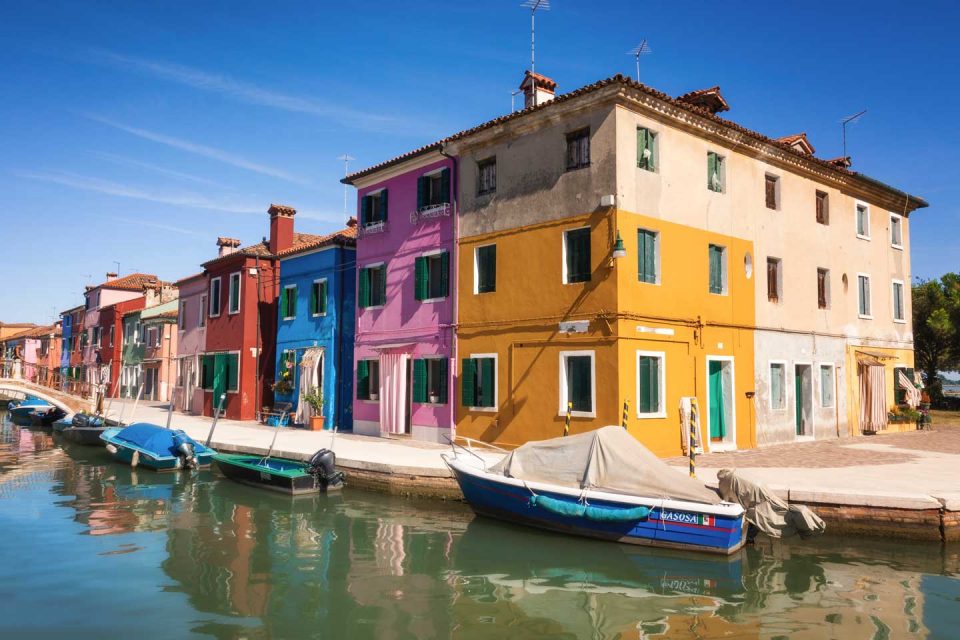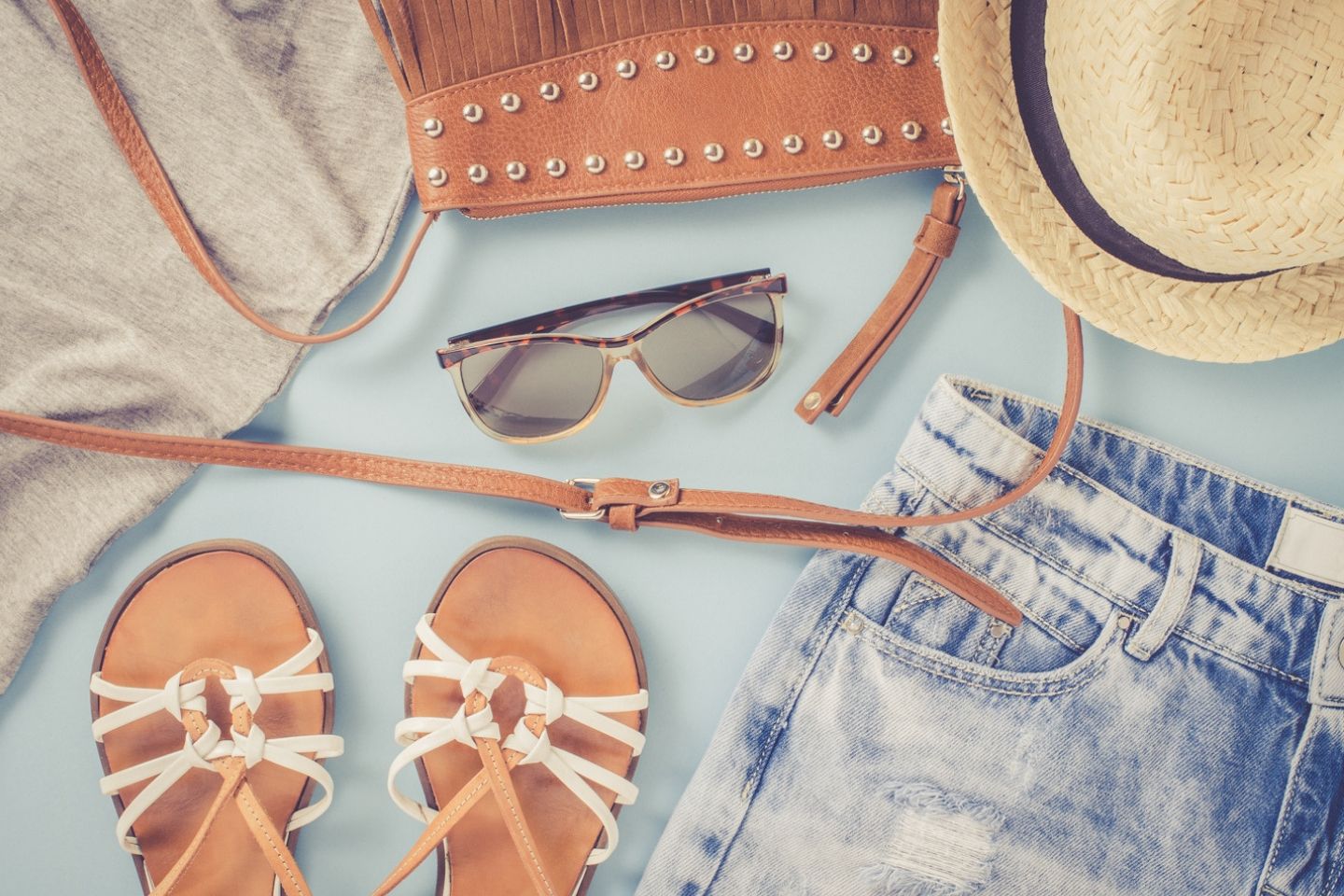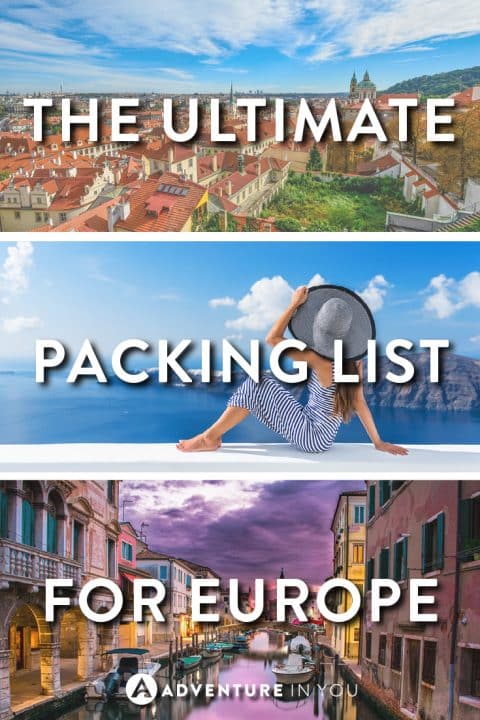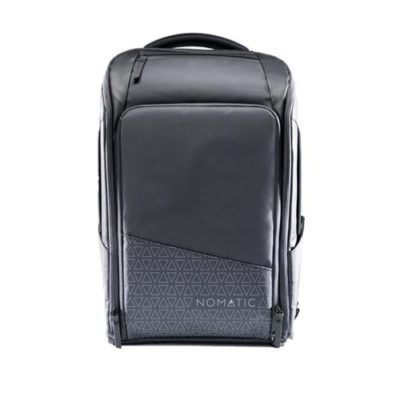In this article, I will walk you through my full-proof Europe packing list to make sure that you don’t miss out on bringing anything important.
Being a European at heart, I do have an ingrained bias towards the continent in terms of travel, food, and general amazing-ness!
Whether you are going on a weekend away, backpacking your way across the continent, deciding what to pack can be different with so many different countries. To help you out, we’ve compiled a packing list for Europe so you can choose what you need.

View Contents
- What Should I Pack for Europe?
- Summer Packing List for Europe: Women’s Clothing
- Winter Packing List for Europe: Women’s Clothing
- Summer Packing List for Europe: Men’s Clothing
- Winter Packing List for Europe: Men’s Clothing
- Choosing the Right Travel Bag for Europe: Backpack vs Rolling Luggage
- Packing for Europe: Essentials
- Toiletries
- Electronics to Bring to Europe
- Other Items to Pack
- Tips for Planning Your Europe Trip
What Should I Pack for Europe?
What to pack for Europe largely depends on where you’re going, what time of year you’re visiting, and what you plan on doing while you’re there.
The weather in Europe greatly varies by season, as well as place. Countries along the coast tend to be cooler due to a constant sea breeze, while countries further inland is a little warmer. However, the weather tends to be similar to the U.S. with cold winters and warm summers.
It’s a good idea to be prepared for anything. Always bring along an umbrella and raincoat because showers will show up when you’re least expecting it.
There’s so much to do and see in Europe that you’ll probably end up walking a ton. Whether you’re talking walking tours of cities or exploring towns on your own, be sure to pack a sturdy pair of walking shoes that you can wear comfortably throughout your trip.

When packing for Europe, you don’t need to bring your finest clothes but most people tend to dress nicely on a daily basis. A pair of jeans (or a sundress in the summer) will be just fine wherever you go.
Overall, it’s a good idea to do a little research on the places you’ll be visiting before your trip so that you can get a good sense of the weather, customs and activities available.
Wherever your European travels take you, you’re sure to have the trip of a lifetime.
Summer Packing List for Europe: Women’s Clothing
Summer in Europe lasts from June to August and generally tends to be comfortable, although some places will be much hotter than others.
You may feel like you’ll need a lot of clothes due to the range of countries and different temperatures but the trick is to layer. There will be plenty of laundry facilities along the way, so choose each item wisely so that what you pack will be suitable to wear throughout your trip.
The key is to keep it simple and bring items which you can mix and match.
During the summer months, you don’t really need much but do still bring a couple of thicker items in case it gets nippy. Obviously, if you’re spending most of your time exploring islands rather than cities, reduce the number of tops and bring more swimwear.
Packing clothing for Europe shouldn’t be a stressful experience. Always remember that less is more. Here are the items you should consider bringing along for a European summer holiday.
Tops & Bottoms


Bring along a couple of t-shirts and tank tops for daily wear with your shorts or other bottoms. Great for strolling around the town or venturing off the beaten path, make sure you’re able to wear the tops you pack more than once.

Bring along a blouse to wear on nicer outings or to a dressy dinner. A lightweight one is best!

There are so many natural wonders throughout Europe just waiting to be explored. Throw on a dri-fit top to wick your sweat away while traversing up mountains or through national parks.
This one works well for exercise and sightseeing!

Pair these shorts with your dri-fit top and you have an athletic outfit that’s sure to keep you cool even when you’re out exploring the outdoors on the hottest days.

Jean shorts and a warm summer day are a match made in heaven. Be sure to pack your favorite pair to wear on walking tours or for discovering a new city.

Throw on a skirt with your blouse for relaxing days in the city or nights out on the town.

It’s nice to have a longer dress to wear while visiting Europe’s many cathedrals and churches. While there often aren’t strict dress codes at these places, it’s nice to dress modestly and respectfully (without sacrificing style).
P.S. This dress is super versatile and has more than 19,000 five star reviews on Amazon!

Stay comfortable and chic in a casual summer dress. There’s nothing like a flowy sundress on a hot summer day.
This one comes in 33 colors and three different styles!


As mentioned, layering is key for traveling in Europe. Bring a long-sleeve shirt or flannel to throw on for travel days or casual, cooler evenings.

If you’re going out at night, it’s nice to have a cute cardigan to wrap yourself in when it gets chilly.

Leggings are perfect for travel days, hanging out in the hostel or hotel, or physical activities.

You’ll definitely want a pair of jeans to wear out to casual dinners or evenings spent wandering around.

This is an absolute must for traveling in Europe. You never know when you’ll get caught in a downpour so be sure to pack a lightweight raincoat with you. I even recommend keeping it in your daypack so you’re never caught by surprise!
Beachwear & Undergarments

If you’re headed to one of Europe’s pristine beaches, you’re definitely going to want a bathing suit for splashing in the sea or soaking up sun on the sandy shore. But even on a city itinerary, you might want a bathing suit for those lazy days lounging by the pool.

A cover-up is perfect for a beach day when you don’t feel like putting on an entire outfit. Go for something lightweight and flowy. Extra points if it dries quickly, too!

Pack a sports bra or two if you plan on doing outdoor activities like hiking or wandering in nature parks.

Bring extra socks on your Europe adventure for all the walking you’ll be doing!

No matter what kind of underwear you prefer, be sure to bring enough to keep you comfortable on your trip.
Footwear & Accessories

Believe me, you’re going to be walking a ton while visiting Europe. Be sure to bring a comfortable pair of sneakers or other walking shoes to keep your feet happy while discovering all that this beautiful continent has to offer.

For the less heavy walking days, a cute pair of sandals are the best for summers in Europe. They’re also good for casual nights out!

If they fit in your bag, bring along a pair of lightweight wedges to wear while experiencing Europe’s nightlife or for that dressy dinner outing you’ll have.

Flip-flops are optional because you’ll be packing sandals, but it may be nice to have a pair to wear when visiting the beach or casual strolls. I wear my Rainbows everywhere and highly recommend investing in a pair if you’re looking for dependable, long-lasting flip-flops.
Related: Check out guide to the best walking shoes for travel.

Whenever I go to Europe, I tend to put on a few pounds thanks to the delicious wine and cheese, which is why carrying a travel yoga mat with me is a must! I love this particular one by Yogo as it is extremely lightweight. The fact that it folds to the size of a newspaper means it doesn’t takes up too much space.

Keep yourself cool with a nice hat on long days spent in the sun. They’re also the perfect prop for photo ops!

Whoever invented the travel scarf is seriously a genius. This is great for travel days to keep all of your valuables close to you and easily accessible. Plus, it’ll keep you warm in air-conditioned rooms.
Winter Packing List for Europe: Women’s Clothing
Winter in Europe is from December to February and can stretch into the spring months as well. It’s typically pretty mild, but can definitely get quite chilly with harsh winds and the occasional snow.
One tip is to check the weather forecast before you go so that you have a sense of what the temperatures will be during your trip.
When packing for the winter months, obviously you will have to take a little bit more. The key is to have really good high-quality base layers to keep you warm throughout the day. From there, you just wear the rest of your clothes in layers.
A good coat and good thermals is all you really need! If you plan on going to places with a lot of snow, some waterproof boots are also recommended.
Pack these items and you’ll stay toasty no matter where you plan on visiting.
Tops & Bottoms

You’ll definitely want a coat during the winter in Europe. I personally always go for a packable down jacket that fits all of my layers underneath and compresses when not in use.
But there are so many different coat options, like this chic number or one with a (faux) fur hood.
Whichever you choose, I recommend wearing your coat on the plane to save space in your luggage!

A thermal base layer is one of the most important items you can pack for a winter European adventure. A good base layer should trap heat close to your body, while wicking moisture away.
Go for one made from wool or fleece and you’ll be happy and warm all-day long.
Just stay away from cotton, which will absorb sweat and make you cold.

On more mild days, you can skip the base layer and wear a t-shirt as your first layer. It’s also nice to have something short-sleeve for places that are overheated.

A few comfy long-sleeve shirts are great for layering on chill days spend sightseeing.

I’m a huge advocate for packing flannels wherever you go, as they’re a convenient layer and easy to take on and off as you please.

Sweaters are the key to looking cute and staying warm on a cold day in Europe. Be sure to pack some that are nice and cozy.

There will be some days on your trip where you’ll want to look more dressed up. Pack a winter skirt for these times and pair with a sweater, tights and boots!

Jeans are great for daily wear during the winter in Europe. If it’s an extra cold or gusty day, throw them on over your base layer, and you’re sure to stay warm all-day long.

Who doesn’t love a good pair of leggings in the winter? I think we can all agree that leggings are a great piece of clothing for travel.
Undergarments

Three words: Fleece. Lined. Tights.
These are the best for the winter, especially if you want to wear a skirt or dress but are worried about being cold. You can also wear these warm tights under your jeans to keep you nice and toasty!

Be sure to bring lots of warm socks to keep your feet cozy in whatever footwear you choose. Wool socks are great for winter.


Don’t forget to pack your underwear!
Footwear & Accessories

During winter, you may want to trade in your sneakers for a pair of comfortable, waterproof ankle boots. Plus, they come many cute styles, completing any winter outfit.

Tall boots are the best for winter, especially if you want to look a little dressy. They’ll also keep your legs nice and warm while you’re wearing them.
Extra points if they’re waterproof as you’re bound to encounter a few wet days during winter in Europe.

Wrap your neck up in a thick winter scarf to keep the chill out and the warm in.
I love blanket scarves when I’m traveling in the winter because when I’m not using it outside, I can wrap it around myself like a shawl!

Keep your fingers warm without sacrificing the use of your phone or other electronics. Gloves with a tech tip are the best for winter travel.

Did you know that most of your head escapes through your head? That’s why it’s so important to wear a warm hat during winter.
Psst...Want in on a Secret? 🤫

We've scoured the internet for the best ALL-AROUND travel shoe and Tropicfeel wins by far. We've taken ours through rivers, jungles, and cities and they're still alive and kickin'. Check them out below.
Summer Packing List for Europe: Men’s Clothing
Men, not to fear, we’ve got you covered with everything you’ll need for a European holiday as well. Your packing will be similar to what women need – lots of layers, good walking shoes, and a lightweight raincoat are key!
During the summer, keep in mind that you’ll have warm days and cooler nights so this is where having lots of layers really come in handy.
Tops & Bottoms


Be sure to pack plenty of t-shirts and tank tops to stay cool while wandering around Europe in the warmer months.

It’s nice to have a dri-fit top on the days when you’ll be doing lots of physical activity, like hiking, to wick the sweat away and keep you feeling nice and cool.

Bring along a polo or two for days when you want to look a little nicer.

It’s a good idea to pack a dress shirt for fancy dinners or nights out.

Throw a flannel on over a t-shirt for chilly nights or windy days. Flannels are great for layering!

As it will be warm most days, you’ll probably be sticking to shorts for most of the trip. Be sure to bring along a few pairs that you can wear more than once!

Good for lounging around, exploring nature parks, and traveling, pack athletic shorts to stay comfortable and cool.

Jeans are great for cooler evenings and nights out during summer months in Europe, especially in coastal cities.

You need to bring along a raincoat for a European trip because you never know when it will start down pouring!
Beachwear & Undergarments

Planning to enjoy some beach time while in Europe? Enjoy the crystal clear waters in Europe with a pair of board shorts!

Pack lots of socks to wear while walking around cities and exploring towns and small streets.

Whether you’re a boxers or briefs kind of guy, pack enough underwear to last your whole trip!
Footwear & Accessories

As your days will be full of walking, you’re going to want to have a pair of comfortable sneakers or shoes to wear throughout your trip.

A pair of dressy shoes are good for when you want to look nicer at fancy dinners or nights out.

You definitely don’t want to wear sneakers to the beach. Bring flip flops for the times when you want to let your toes feel free!

Keep the sun out of your eyes with a trusty hat to wear on long days in the sun.
Winter Packing List for Europe: Men’s Clothing
Protect yourself from strong gusts of wind and winter chills with a cozy base layer and a good coat, no matter where you go in Europe!
Tops & Bottoms

You absolutely need a coat for winter travel in Europe. A lightweight down jacket is best for travel, but there are lots of other options, like this sharp wool pea coat.

You’ll want something to trap your body heat on the colder days in Europe. A snug-fitting wool or fleece base layer will do the trick!

It’s nice to have a t-shirt to wear under your warmer layers on nicer days. A t-shirt also comes in handy when you’re in overheated places.

Long-sleeve shirts are what you’ll be wearing mostly during winter in Europe so pack a few that you can wear several times.

A button-down shirt is good to have for times when you have to dress a little nicer but still want to be warm.

As always, a flannel is a great layer to have. In addition to being warm, it’s easy to take on and off, and goes with a variety of different outfits.

Throwing a sweatshirt on over your other layers will surely keep you warm on days you’ll be spending a lot of time outside. It’s also good to have one for traveling.
The best part about sweatshirts is that they can double as pillows when you don’t have one!

Jeans are an all-season pant. Pack a pair or two to wear on a daily basis throughout your trip.

It may be nice to have a pair of long pants that aren’t jeans for nice restaurants and nights out.
Undergarments

Wool socks are best for winter, but any pair works as long as they keep your feet warm in a pair of winter shoes.

Pack enough underwear to last you through your trip!
Footwear & Accessories

Bring a pair of boots for winter walking! It’s best if they’re waterproof and insulated to keep you toasty on long days spent exploring.

Wrap a scarf around your neck to be sure nothing is exposed on colder days. Plus, it’s totally European fashion, so you’re sure to blend in with other men out on the street.

Tech gloves are so useful for colder months because you can still use your phone without sacrificing warmth.

Keep all your heat in with a warm hat or beanie.
Choosing the Right Travel Bag for Europe: Backpack vs Rolling Luggage
Choosing the right travel bag is the first step to packing for any trip. The age old question is whether to go with a traditional suitcase with wheels or fit everything into a backpack.
Quick Answers (Our Top Recommendations):
Backpack: Osprey Farpoint
Daypack: Nomatic Travel Pack
Suitcase: American Tourister Expandable Carry-On
Backpack
My preferred luggage is definitely a backpack because I find them to be much more practical for traveling, especially if you have lots of different places on your itinerary.
However, like anything, there are certain pros and cons to traveling with a backpack.
Pros: Traveling with a backpack means having your hands free. This is especially useful for navigation, photo taking, and walking on cobblestone. It’s also easier to be in crowded places wearing a backpack than rolling a suitcase, especially on uneven streets. Finally, backpacks have tons of pockets and compartments, making for quick access instead of having to open everything up to find what you’re looking for.
Cons: Carrying all of your belongings on your back can be uncomfortable, especially if you’ve packed a lot and aren’t used to carrying a heavy pack. It can also be more challenging to fit everything you want to take in a backpack. Lastly, if your backpack isn’t the right size or fit, it can cause serious discomfort and even pain.
With so many different backpacks on the market, choosing the right one may be challenging for first-timers.
Here are a couple of my favorites that are practical for a Europe trip.

This backpack is a super versatile piece of gear. While it may be a backpack, it opens up like a suitcase, making packing and finding your belongings super convenient and easy.
It’s also a good size, allowing you to fit everything you need without overpacking. Not only that, but it’s carry-on compatible! The Farpoint comes in different sizes and colors, making sure there’s something for everyone.

The Fairview is similar to the Farpoint as it opens like a suitcase. It’s a top-rated backpack for women, and also comes in different sizes and colors.

If you can’t decide between a backpack and rolling luggage, the Sojourn is certainly the one for you. It has wheels and a handle for when you don’t feel like carrying it on your back, but padded straps for when you do. This backpack is a serious game changer for some people!
If you’re looking for more backpack options, check out our complete article on best travel backpacks.
Rolling Luggage
If you’re more of a traditionalist, you may want to stick with rolling luggage for your Europe trip. Rolling luggage in Europe is certainly more practical than other places in the world (especially Asia) but still has it’s downsides.
Here are some pros and cons to packing in a suitcase:
Pros: You don’t have to carry everything on your back, meaning you may be able to pack more than you can in a backpack. A hard shell also means your belongings on the inside have more protection from outside forces.
Cons: A lot of places in Europe have streets filled with cobblestones, making wheeling a suitcase challenging and impractical. Many places in Europe (hostels, train stations, etc) also may be lacking elevators, which means lugging your bulky suitcase up several flights of stairs. Lastly, you need to use your hands to wheel your suitcase, making navigation, picture-taking and other activities difficult while moving around with your bag.
A wheeled suitcase in Europe is best if you plan on taking lots of taxis to your accommodation and little public transportation. Going door-to-door with a wheeled suitcase will pose few problems.
Here are some suitcases that I recommend.
This is a great roller suitcase for traveling anywhere in the world.
The hard shell makes sure your belongings are protected on the inside and the swiveling wheels make it convenient for navigating through transit stations and small streets. There’s even a charging port on the side for connecting a power bank!
Best of all, it’s expandable but still carry on size for sneaking in a couple extra outfits.
American Tourister Hardside Carry On

A nice hard side carry-on suitcase, this roller bag is small enough to bring on the airplane but large enough to fit everything you’ll need for a trip to Europe. It’s sturdy with nice wheels and even comes in 5 beautiful colors!
No matter which bag you choose to take with you, I highly recommend using packing cubes. Packing with cubes will change your life and keep you more organized than ever before!
Daypack Picks
Besides your main travel bag, you’re also going to want to have a trusty lightweight daypack to keep your knick-knacks in while traveling and to take along on day trips.
If you’re someone who carries a lot of gear (cameras, chargers, iPads), the Nomatic Bag is for you. Hands down, one of the best bags we’ve ever owned, this day pack makes it so convienient to pack and unpack. With a gazillion different compartments, it makes sure you have a home for everything in your bag, completely saving you from having to rummage through your bag again.
Packing for Europe: Essentials
The “essentials” will change depending on person, as business travelers may carry more gadgets than an average backpacker or holiday-maker for example. This list of essential travel accessories below is recommended for general travel.
You may not need all of these items if you’re planning on staying in nicer hotels, but if you’re a budget traveler and staying in hostels, we would suggest bringing these items along.

An umbrella is definitely an essential item for traveling in Europe. Weather can be unpredictable, so it’s better to be prepared with a small collapsible umbrella that you can carry around in your daypack.

If you’re staying mainly in hostels, it’s a good idea to bring your own towel as many won’t provide them. Quick-dry towels are practical for travel because they don’t stay wet for very long, making them easy to repack when you’re ready to move to a new location.

It’s important to stay hydrated, especially while doing lots of walking during warm months! A collapsible water bottle is good for travel because it can fold up when not in use.

It’s nice to have your own padlock for hostel lockers and times when you leave your luggage unattended where you’ll be staying. Always keep your belongings secure from theft!

No matter how goofy you look, you’ll be so happy you have ear plugs and an eye mask at some point on your trip. Whether it’s for long travel days or noisy hostels, this set will come in handy at one point or another.

Keep your passport, important documents, cash and cards all safe in one place. Travel wallets are great because there are many pockets for storing some of your most important belongings.
Toiletries
You can always buy toiletries when you get to your destination, so if you need to save space, these are the things to sacrifice! However, if you have sensitive skin or like certain products and have space, then you may prefer to bring them with you.
One thing I do recommend taking of your own is sunscreen. It can be really expensive in the sunny countries as they don’t use it all too often.
Here’s a basic list of toiletries that you should bring along with you, if you plan on packing your own:
- Shampoo & Conditioner
- Body & Face Wash
- Toothbrush & Toothpaste
- Razor
- Deodorant
- Lip Balm
- Wet Wipes
- Bugspray
- Sunscreen
- Hand Sanitizer
- Feminine Hygiene Products
- Medicine (prescriptions, pain killers, motion sickness medication)
If you’re worried about all the weight these toiletries may add, I recommend opting for a complete travel toiletry set. They come in both men and women’s products and have everything you’ll need for a holiday!

Electronics to Bring to Europe
These days we all have quite a lot of electronics that we can’t go without, and in some instances, if you work online you actually can’t go without!
Whether you’re a digital traveler or like to leave most of your gadgets at home, it is worth checking out this list to see what you may need. Just remember to always look after your valuables and be cautious.
A quick note on using your phone: in my opinion, it’s best to travel with an unlocked phone that allows you to put in a foreign SIM card (you can find these at the airport!) to use throughout your trip. That said, many phone companies have roaming plans at a set daily rate. Be sure to check with your provider before your trip so there aren’t any surprises when you arrive!

If you need to work on the go, you’ll have to bring along your laptop and charger. You may also want this to watch movies or surf the web, if you have long travel days during your trip.

Skip the books this trip and bring thousands of titles on one small, lightweight device. Kindles are practical for travel, and make reading on the go convenient without the extra weight.
Headphones & Headphone Splitter


Bring headphones so you have a soundtrack for your trip! If you’re traveling with a companion and want to share your music, a headphone splitter is an awesome little tool that allows you to plug two pairs of headphones into one device.

My GoPro comes with me on all of my adventures, no matter what continent I’m on. They’re durable, waterproof and small making for the ideal travel camera.

If you’re a more advanced photographer, bring along your camera and all necessary equipment. Definitely pack some extra SD cards so that you never run out of space!

For long days exploring or traveling, it’s nice to keep your electronics charged with a portable power bank.

To plug anything in, you’re going to need a converter (unless your plugs are from Europe in the first place). While Europe has its own specific plug, it’s worth investing in a universal converter for future travels in different places.
Other Items to Pack
Besides everything listed above, I recommend packing these extra items to have a safe, comfortable, fun and memorable trip.

Be prepared for anything the world might throw at you with a travel first aid kit filled with band-aids and beyond. It’s better to be safe than sorry! Besides everything listed above, I recommend packing these extra items to have a safe, comfortable, fun, and memorable trip.

It’s nice to travel with a journal to document your trip along the way. There’s nothing quite as special as looking back on a journal from a trip you loved!

Keep your eyes shaded with a pair of stylish sunglasses. Make sure you get a great brand that is ideally polarized to protect your eyes!

It’s nice to have a travel pillow if you plan on taking lots of trains and buses to get from place to place.

Trust me, these will come in handy at some point or another. Whether you need to stash something that’s wet or leaking, or just need to stay organized, ziplock bags in all different sizes are one of the most useful things you can bring along.
Tips for Planning Your Europe Trip
There are a few things to keep in mind when planning a trip to Europe. This section is here so you have access to all important information in one place!
Visa
There are 26 European countries that make up the Schengen Area which allows visitors from many countries to enter for 90 days without a visa for a tourist-related visit. Just make sure your passport is valid for 6 months past your time of entry!
The countries that are included in this visa exemption are the U.S., Canada, Australia, New Zealand, Japan, South Korea, and many countries in Central and South America. You can check current visa requirements here.
Currency
Most countries in Europe use the Euro, simplifying currency while traveling between different places. These countries make up the European Union, but even select places outside of the EU still use the Euro like Montenegro and Monaco.
There are some countries in Europe that use their own currency. These countries are mostly in Western Europe and include the U.K., Sweden, Denmark, Norway, and Switzerland.
Besides those mentioned, other countries like Bulgaria, Croatia, the Czech Republic, Hungary, Poland, Serbia, Turkey, and a handful of others also use their own currencies.
You can find more information about currency in Europe and complete country lists here.
Transport Around Europe
While Europe is a large continent, traveling between countries is common and quite convenient. There are many ways to travel around Europe, whether you’re interested in public transportation, renting a car, or flying.
Insider Tip: We love renting cars whenever we travel, especially in Europe — it just gives you so much freedom to explore at your own pace. Plus, nothing is quite as dreamy as driving up and down a Mediterranean coast… Click here to compare car rental prices. You’ll be surprised at how affordable it is!
One of the most common ways travelers visit many places on a European trip is with the purchase of a Eurail Pass. If you plan on going to lots of different countries or want to travel at short notice this may be a good way to do it, but it’s a bit costly and you can only buy the pass before you arrive in Europe (unless you’re European).
If you don’t want to purchase the whole pass, you can buy individual tickets. Just make sure you book in advance because last-minute tickets can be quite expensive!

We recommend downloading the Skyscanner App and using Bookaway to view bus, boat, and train schedules ahead of time. We’ve used these websites all over Asia and it saves us the hassle of lining up in travel agencies or bus stations.
Overall, traveling around Europe is quite easy and convenient, with lots of options suited to different budgets and preferences.
Europe Safety Tips
While Europe is relatively safe as a whole, it’s important to take certain precautions to make sure you have a secure and stress-free trip.
Europe isn’t known for violent crimes, but it is known for pickpockets and thieves. Don’t travel with a lot of cash or flashy jewelry. Nothing says “easy target” like pulling out a large wad of bills to pay for a bottle of water or wearing your finest jewelry around your neck.
Be smart when traveling and only carry what you need with you. It’s a good idea to have a money belt to keep your valuables close to you while still being easily accessible. But whenever possible, leave valuables in your hotel room where they’re safest.
Pickpockets and thieves are something to be hyper-aware of, especially in touristy areas.
When stopping for a quick rest or lunch, keep your bag attached to you somehow (loop your arm or leg through it) to prevent someone from grabbing it and running off with it. Be sure to always be on your guard, keep your valuables close to you and have copies of important documents of the off chance they’re stolen.
Always travel with photocopies of your passport and bank cards. This makes getting new ones a hundred times easier and will save your life when you least expect it. Also be sure to avoid empty areas at night and stay in well-lit places. Train stations are a common place for thieves to hang out as well so keep your belongings on you at all times.

It’s advisable for women to carry a cross-body bag with a zipper to keep your belongings in. You should also avoid keeping things like your wallet and phone in your back pocket.
Besides pickpockets, Europe is also full of tourist travel scams that you should be aware of. Be sure to always confirm prices before taking a cab (or make sure that they will stick to the meter fare before getting in).
Also be aware of deals that seem too good to be true, like someone offering to sell you a gold ring that they “found” or partaking in a demonstration by a vendor that will result in you paying at the end. Always carefully count your change when you buy something and be wary of over-friendly locals who may be trying to rip you off.
Other Resources
So there we have it, everything you could possibly need when traveling to Europe!
We all fall prey to packing too much, so just take some time and think about only bringing items which you can use more than once. When you think of the uses and plan in advance, you are more likely to just pack the necessities.
So pack smart and travel light, and if you’ve forgotten anything, simply buy it there. Packing for a big trip is only a small part of your travels, so if you plan ahead of time, you can focus less on packing and more on having fun and planning for your trip.
Happy travels!
Additional content contributed by Jane Elmets
Disclaimer: Adventure In You is a participant in the Amazon Services LLC Associates Program, an affiliate advertising program designed to provide a means for us to earn fees by linking to Amazon and affiliated sites at no additional cost to you. Please note we only link to products & services we personally use or trust.
If you’re looking for other Europe travel resources or inspiration, check out these articles
- 15 Travel Tips for Europe That You Need to Know
- Tips on How to Travel Europe Cheaply
- Europe in Winter: The Best Destinations to Visit
- 12 of the Best Beaches in Europe That Will Blow You Away
Inspired? Pin it!


Such a great list. Love the photos too. It’s can be hard to visualise what we need to pack
Great list! It is so comprehensive and I love that you put in some images for the clothing!